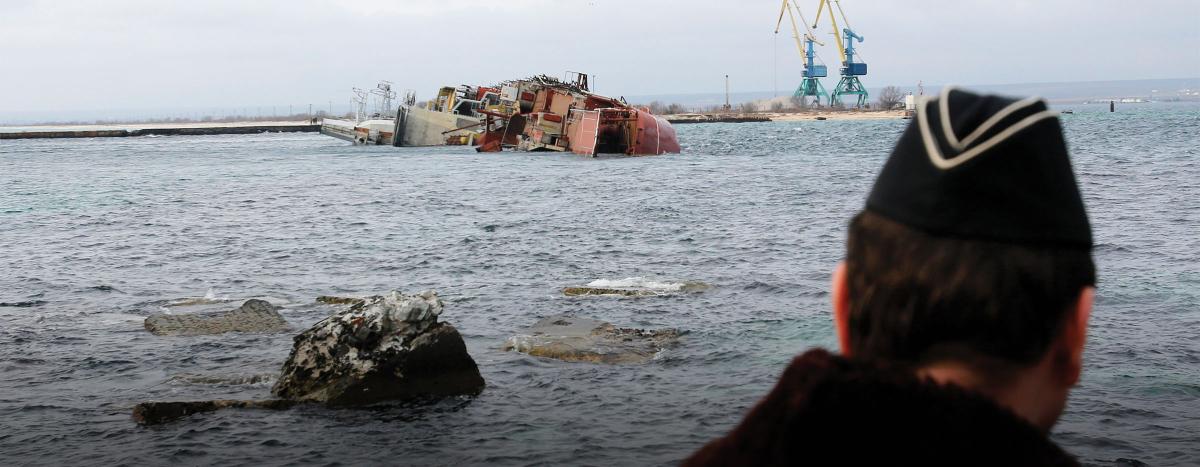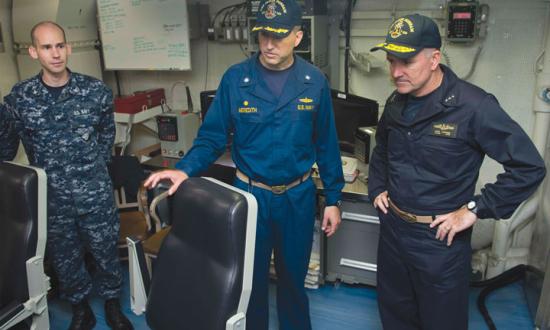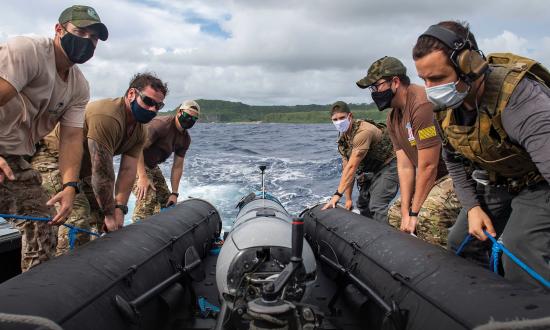The March 2021 Suez Canal blockage, though an accident, is a reminder of the potency of an old naval tactic: sinking a ship to block a critical channel. The U.S. Navy should explore opportunities to use this simple, low-cost, time-honored tactic—called blockship attacks—to trap enemy submarines and ships in port during conflict.
Russia most recently used this tactic during its 2014 annexation of Crimea, sinking two obsolete vessels to trap most of the Ukrainian Navy in port. In World War II, British forces used blockships to obstruct the entrances of German-occupied ports. During the American Civil War, Union forces used them in Charleston Harbor to impede blockade runners.
Blockship attacks remain a useful tactic today, as noted in a 2013 RAND report and a more recent commentary.1 In an impending or ongoing Chinese invasion of Taiwan, for example, the United States could use blockships in multiple ports to prevent Chinese warships and commandeered civilian vessels from getting to sea. Similarly, impeding the departure of some Chinese submarines could reduce the amount of damage they could inflict and allow U.S. and allied antisubmarine warfare (ASW) forces to focus their efforts on fewer threats. Russia, Iran, and North Korea all have naval bases near heavily trafficked commercial shipping routes where blockship attacks could be effective.
A blockship attack has a temporary effect. Given time—likely days to weeks—and resources, the defenders will clear the wreck so traffic can resume. However, inflicting delays on an enemy can buy critical time for the United States and its allies to surge forces into theater while needing to track and engage only a fraction of the enemy fleet.
A Modern Blockship Attack
Today, the Department of Defense (DoD) could create a shell company to buy old commercial ships, then contract them to transport cargo along world shipping lanes. When conflict appears imminent, Navy sailors—perhaps with assistance from the U.S. Merchant Marine—could sail the ships toward their targets, preparing the ships along the way. They would install an autonomous navigation system (such as the Office of Naval Research’s Control Architecture for Robotic Agent Command and Sensing), emplace a variety of booby traps and other impediments throughout the vessels and their cargo to interfere with clearance efforts, rig cables and nets to entangle enemy unmanned undersea vehicles (UUVs) and other equipment, and set motion-triggered explosive charges to further impede salvage efforts. Large quantities of explosives concealed in some cargo containers would detonate when lifted by cranes. Decoy information technology (IT) hardware that could easily be carried away would be conspicuously placed throughout the ships’ bridges; these devices might contain malware, transponders, intermittent jammers, or even small explosive charges. The ships would be studded with a network of cheap, small jammers and sensors that would be hard-wired to long-lasting batteries, as well as to the ships’ own power systems and to antennae on the uppermost decks. Largely concealing these items with detritus—which also would be freely distributed around the ship, and some of which could be booby-trapped—would make them hard to spot. Most important, large quantities of explosives would be placed in key locations to ensure the ships sank rapidly when desired, with enough compartments breached that refloating them would not be viable.
After a ship was suitably endowed and within reasonable range of her target, the personnel would disembark, perhaps by rendezvousing with small vessels. The ship would veer off course to her target, still in communication with DoD, and turn off her transponders. If the ship were noticed and queried, personnel speaking via the bridge could claim she was experiencing mechanical trouble. Once within a few miles of her target, sheer momentum would make the ship hard to stop, even if bombed or targeted with missiles. The Ever Given, which blocked the Suez Canal, weighs 220,000 tons (about twice the mass of a Ford-class aircraft carrier).2 While repeatedly torpedoing a blockship might cause her to sink prematurely, the timeline for taking such action during an ambiguous situation likely would be longer than what would be required for the vessel to reach the chokepoint.
Firmly ensconced in the channel, the vessel would be difficult to remove. Unlike the Ever Given, which remained floating and was freed primarily by dredging some of the material on which she had run aground, the scuttled blockship would require underwater demolition. Personnel would need to employ cutting tools and explosives within the wreck to break it apart. Under the best conditions, this would be a gargantuan task, requiring numerous highly skilled personnel and specialized machines to work for days or weeks. The explosives placed throughout the ship would greatly protract this timeline, as demolition would be painstaking work. UUVs or tethered underwater remotely operated vehicles (ROVs) entering the wreck would snag on cables and netting, and sometimes detonate motion-sensitive charges. Those charges would be small enough to avoid doing meaningful damage to the ship, but large enough to destroy a vehicle’s sensitive equipment. Cranes attempting to move cargo off the ship would be damaged when some of the containers they grasped suddenly detonated. While UUVs, ROVs, and cranes can be fixed or replaced, doing so takes precious time.
Any decoy IT hardware removed from the bridge for inspection would facilitate the spread of malware, create intermittent jamming issues, and reveal where it was being taken by occasionally transmitting. Electronic jammers hidden above the waterline would hinder communication among the personnel and machines conducting the response. Using a rotating chorus of jammers would make them hard to find: each jammer would create interference on key channels for a couple moments, then turn off before it could be localized. The same devices could also relay intercepted voice communications back to U.S. forces via satellite, and U.S. personnel could relay back deep-faked audio files for the devices to broadcast, providing conflicting instructions to enemy clearance personnel. Similarly, networked sensors above and below the waterline would provide U.S. forces with situational awareness regarding the clearance effort, enabling them to interfere with it. They could detonate concealed explosives within the ship precisely when they would inflict the most damage, coordinate cyberattacks and jamming behaviors, or even launch missile attacks against the response effort when critical equipment was most concentrated.
Even if the clearance crew attempted to accelerate timelines and reduce risk by repeatedly bombarding the ship, as opposed to a precise demolition, that would not eliminate the underlying problem. Bombardment alone would result in various jagged-edged protrusions under the water. UUVs, divers, and cranes would still be needed to clear the wreck, and they would be in danger from unexploded ordnance. Bombardment also could disturb the channel, requiring a substantial dredging effort after it was complete.
Performing blockship attacks at multiple ports could oversaturate a nation’s ability to clear them simultaneously, exceeding the capacity of specialized equipment and personnel. Finally, naval mines could further stymie attempts to clear the channel. If the ship had an automated mechanism for deploying mines overboard, the crew could lay several just before scuttling the vessel. After the wreck was finally cleared, if the first ship to transit the channel sustains enough mine damage that it quickly sinks, the problem is recreated. If it does not, the adversary still must deal with a mine countermeasures problem that requires substantial specialized resources and additional time.
The Blockship Advantage
Blockships have tremendous cost-effective potential for thwarting adversary forces. An old rust bucket of a ship, costing tens of millions of dollars, can trap an enemy fleet costing many times that. The installation of jammers, sensors, netting, booby traps, or other devices is unlikely to dramatically change this cost differential, and all these systems involve minimal development risk. Given ever-improving autonomous navigational technology, this tactic does not even require U.S. personnel to enter harm’s way. By using blockships, a navy could transform an adversary’s prized fleet into a useless set of fixed targets just when it is most critically needed. For all these reasons, the U.S. Navy should initiate a blockship program to counter potential threats.
1. Scott Savitz, et al., U.S. Navy Employment Options for Unmanned Surface Vehicles (USVs) (Santa Monica, California: RAND Corporation, RR-384-NAVY, 2013); see also Scott Savitz, “The Suez Grounding Was an Accident—The Next Blocked Chokepoint Might Not Be,” The RAND Blog, 30 March 2021.
2. Mary-Ann Russon, “The Cost of the Suez Canal Blockage,” BBC News, 29 March 2021.






